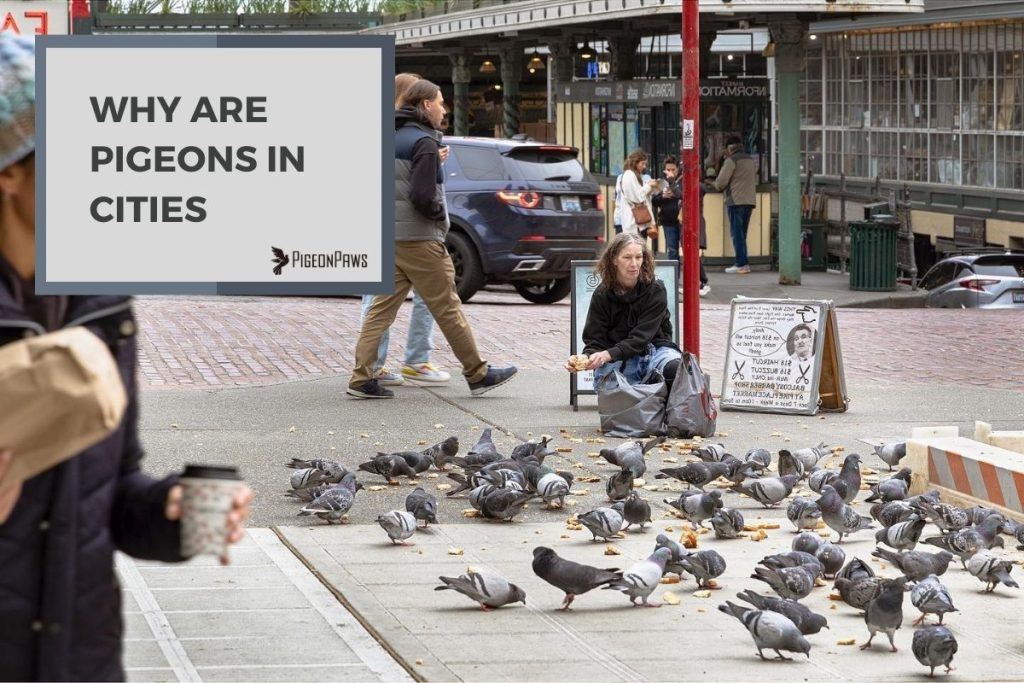Why Are Pigeons in Cities? Unraveling Their Urban Habits

Day by day pigeons population is increasing in the world’s major cities. In fact, they are almost everywhere, from the streets to the parks and even on the balconies of residential buildings. But why are pigeons in cities?
Pigeons became integral to city life when they were first used to deliver important messages. These birds have been a feature of city life since prehistoric times. In reality, the first evidence of humans domesticating pigeons dates back to Mesopotamia 5,000 years ago.
Here I aim to answer the question of why pigeons are in cities by exploring where they originally come from, how they adapt to the urban environment and more. So Please stay tuned to the end for further information!

How Do Pigeons Adapt To Urban Environments?
Pigeons have adapted well to urban environments, and several factors have contributed to their success in cities. These include:
- Ability to survive: Pigeons are highly adaptable birds that can thrive in a wide range of environments. They are able to find food and shelter in urban areas and are not easily discouraged by human activity.
- Feeding habits: Pigeons are opportunistic feeders that will eat almost anything. In cities, they feed on a variety of food sources, including discarded human food, bird seed, and seeds from plants. They are also attracted to feeding stations where people leave food out for them.
- Breeding habits: Pigeons are highly prolific breeders, and their populations can grow quickly in cities. They prefer to nest in sheltered areas, such as on building ledges or in bridges, and they are able to lay multiple eggs in a single year.
So we can say that, pigeons have successfully adapted to urban environments and have become a ubiquitous part of the cityscape. Their ability to find food, shelter, and breeding sites in cities has enabled them to thrive in these environments.
What are the Pros and Cons of having Pigeons in Cities?
The presence of pigeons in cities has both positive and negative effects on urban environments. Some of the pros of having pigeons in cities include the following:
- Providing a source of food for other animals: Pigeons are an important source of food for predators, such as hawks, in cities.
- Adding to the biodiversity of cities: Pigeons help to increase the biodiversity of cities by adding to the number of bird species present.
- Being a source of enjoyment for people: Pigeons are often seen as charming birds, and many people enjoy watching them and feeding them.
However, there are also several cons to having pigeons in cities, including:
- Health concerns: Pigeons can carry diseases that are harmful to humans, such as salmonella, E. coli, and histoplasmosis.
- Property damage: Pigeons can cause damage to buildings, statues, and other structures in cities by nesting on them and leaving droppings.
- Contaminating food and water sources: Pigeons can contaminate food and water sources in cities with their droppings.
Overall, the presence of pigeons in cities has both positive and negative effects. It is important for cities to carefully manage their pigeon populations to minimize the negative effects while still allowing the birds to thrive.
What Measures Are Being Taken To Control The Pigeon Population In Cities?
Cities have implemented several measures to control the pigeon population and minimize the negative impacts on the birds. Some of these measures include:
- Using bird repellents: Cities have used various bird repellents, such as plastic spikes and electric wires, to prevent pigeons from roosting on buildings and other structures.
- Modifying city architecture: Cities have made changes to city architecture, such as reducing the size of ledges and overhangs, to make it more difficult for pigeons to nest in urban environments.
- Relocating pigeons: Some cities have relocated pigeons to rural areas to reduce their population density in cities.
- Feeding restrictions: Cities have implemented restrictions on feeding pigeons to reduce the amount of food available to them in urban environments.
- Sterilization programs: Some cities have implemented sterilization programs for pigeons in order to reduce their population growth.
Overall, cities have implemented a variety of measures to control the pigeon population and minimize the negative impacts on the birds.
These measures have been effective in reducing the pigeon population in some cities, but they have also been met with controversy in others. It is important for cities to carefully consider the pros and cons of each measure and find a balance that works for their specific situation.
What Is the Connection Between Pigeons’ Urban Habits and Their Excessive Pooping?
Pigeons’ urban habits have a direct connection to the purpose and impact of pigeon poop. These birds have adapted to city life, finding a constant food supply and suitable nesting spots. However, their excessive pooping can cause various problems for buildings, public spaces, and even human health. The abundance of food sources contributes to increased pigeon populations, resulting in more droppings and potential hazards.
Conclusion
It’s easy to see why pigeons have become so ubiquitous in urban areas. They are hardy birds that can easily adapt to their environment. Humans have domesticated them for centuries, and they are an important part of city life.
While they can be a nuisance to some, the pros of having pigeons in cities outweigh the cons overall. They provide a source of joy to many and can make otherwise dull cities livelier and more vibrant.

